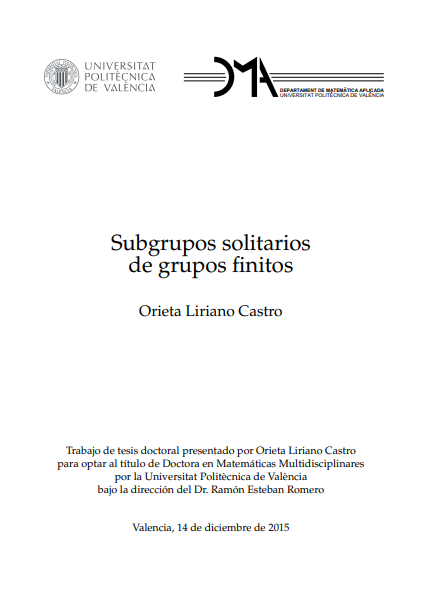Subgrupos solitarios de grupos finitos
Licencia: Creative Commons (by-nc-nd)
Autor(es): Liriano, Orieta
The scope of this thesis is the abstract finite group theory. All the groups we will consider will be finite. hence, the word "group" will be understood as a synonimous of "finite group". We say that a subgroup H of a group G is solitary when no other subgroup of G is isomorphic to H. A normal subgroup H of a group G is said to be normal solitary when no other normal subgroup of G is isomorphic to H. A normal subgroup N of a group G is said to be quotient solitary when no other normal subgroup K of G gives a quotient isomorphic to G/N. Solitary subgroups, normal solitary subgroups, and quotient solitary subgroups have been recently studied by authors like Thévenaz, who named the solitary subgroups as strongly characteristic subgroups, Kaplan and Levy, Tarnauceanu, and Atanasov and Foguel. The aim of this PhD thesis project is to deepen into the analysis of these subgroup embedding properties, by refining the knowledge of their lattice properties, by obtaining general properties related to classes of groups, and by analysing groups in which the members of some distinguished families of subgroups satisfy these embedding properties. The basic results of group theory that will be used in the memoir appear in Chapter 1. Among them, we comment on some results about soluble groups, supersoluble groups, nilpotent groups, classes of groups, and p-soluble and p-nilpotent groups for a prime p. In Chapter 2, we present the basic concepts about these embedding properties, as well as some basic results satisfied by them. Chapter 3 is devoted to the study of lattice properties of these types of subgroups. In this chapter we deepen into the study of the lattices of solitary subgroups and quotient solitary subgroups developed by Kaplan and Levy and by Tarnauceanu and we check that, even though these lattices consist of normal subgroups, they are not sublattices of the lattice of normal subgroups.
[Valencia: 2015]
Compartir:
Una vez que el usuario haya visto al menos un documento, este fragmento será visible.


